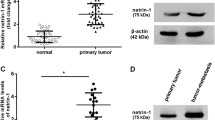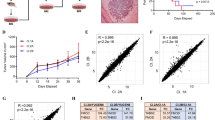Abstract
c-Myc is a well-characterized proto-oncogene that induces cellular transformation and modulates programmed cell death. While recent studies have demonstrated high expression of c-Myc protein in advanced and metastatic melanoma, the clinical and biological implications remain to be fully elucidated. In this study, we investigated the effect of c-Myc overexpression in melanoma tumorigenesis. Clinicopathological analysis demonstrated that c-Myc expression positively correlated with the formation of vasculogenic mimicry (VM) and linearly patterned programmed cell necrosis (LPPCN). Clinically, high c-Myc expression was significantly associated with distant metastasis and poor prognosis, while biologically, c-Myc overexpression led to significant increases in cell motility, invasiveness and metastasis. Moreover, c-Myc induced the formation of VM and promoted the expression of epithelial-mesenchymal transition (EMT)-associated protein Snail both in vivo and in vitro. High expression of c-Myc increased Bax expression in hypoxic conditions and induced cell apoptosis. Taken together, we conclude that c-Myc overexpression promotes the formation of VM by EMT and LPPCN in melanoma. Our improved understanding of the clinical and biological effects of c-Myc overexpression in melanoma highlights the incomplete understanding of this oncogene, and indicates that c-Myc is a potential therapeutic target of this disease.
Key message
-
High c-Myc expression is associated with tumor metastasis and poor prognosis in human melanoma.
-
c-Myc upregulates Snail expression to promote EMT via the TGF-β/Snail/Ecadherin signal pathway.
-
c-Myc leads to cell death by upregulating Bax expression causing a lower Bcl2/Bax ratio under severe hypoxic conditions.
-
c-Myc promotes vasculogenic mimicry and linearly patterned programmed cell necrosis.







Similar content being viewed by others
References
Caini S, Boniol M, Botteri E, Tosti G, Bazolli B, Russell-Edu W, Giusti F, Testori A, Gandini S (2014) The risk of developing a second primary cancer in melanoma patients: a comprehensive review of the literature and meta-analysis. J Dermatol Sci 75:3–9
Ji H, Cao R, Yang Y, Zhang Y, Iwamoto H, Lim S, Nakamura M, Andersson P, Wang J, Sun Y, et al (2014) TNFR1 mediates TNF-α-induced tumour lymphangiogenesis and metastasis by modulating VEGF-C-VEGFR3 signalling. Nat Commun 5:4944
Hedlund EM, Yang X, Zhang Y, Yang Y, Shibuya M, Zhong W, Sun B, Liu Y, Hosaka K, Cao Y (2013) Tumor cell-derived placental growth factor sensitizes antiangiogenic and antitumor effects of anti-VEGF drugs. Proc Natl Acad Sci U S A 110:654–659
Folkman J, Ryeom S (2005) Is oncogene addiction angiogenesis-dependent? Cold Spring Harb Symp Quant Biol 70:389–397
Cao Y (2016) Future options of anti-angiogenic cancer therapy. Chin J Cancer 35:21
Cao Y (2014) VEGF-targeted cancer therapeutics-paradoxical effects in endocrine organs. Nat Rev Endocrinol 10:530–539
Cao Y, Arbiser J, D’Amato RJ, D’Amore PA, Ingber DE, Kerbel R, Klagsbrun M, Lim S, Moses MA, Zetter B, et al (2011) Forty-year journey of angiogenesis translational research. Sci Transl Med 3:114rv113
Maniotis AJ, Folberg R, Hess A, Seftor EA, Gardner LM, Pe’er J, Trent JM, Meltzer PS, Hendrix MJ (1999) Vascular channel formation by human melanoma cells in vivo and in vitro: vasculogenic mimicry. Am J Pathol 155:739–752
Cao ZF, Bao MM, Miele L, Sarkar FH, Wang ZW, Zhou QS (2013) Tumour vasculogenic mimicry is associated with poor prognosis of human cancer patients: a systemic review and meta-analysis. Eur J Cancer 49:3914–3923
Meng J, Sun B, Zhao X, Zhang D, Zhao X, Gu Q, Dong X, Zhao N, Liu P, Liu Y (2014) Doxycycline as an inhibitor of the epithelial-to-mesenchymal transition and vasculogenic mimicry in hepatocellular carcinoma. Mol Cancer Ther 13:3107–3122
Sun T, Zhao N, Zhao XL, Gu Q, Zhang SW, Che N, Wang XH, Du J, Liu YX, Sun BC (2010) Expression and functional significance of Twist1 in hepatocellular carcinoma: its role in vasculogenic mimicry. Hepatology 51:545–556
Kalluri R, Weinberg RA (2009) The basics of epithelial-mesenchymal transition. J Clin Invest 119:1420–1428
Zhang S, Li M, Zhang D, Xu S, Wang X, Liu Z, Zhao X, Sun B (2009) Hypoxia influences linearly patterned programmed cell necrosis and tumor blood supply patterns formation in melanoma. Lab Investig 89:575–586
Hoffman B, Liebermann DA (2008) Apoptotic signaling by c-MYC. Oncogene 27:6462–6472
Evan G, Littlewood T (1998) A matter of life and cell death. Science 281:1317–1322
Blum D, Hao H, McCarthy M, Reproducibility Project: Cancer B (2015) Registered report: transcriptional amplification in tumor cells with elevated c-Myc. Elife 4.e04024. doi:10.7554/eLife.04024
Meyer N, Penn LZ (2008) Reflecting on 25 years with MYC. Nat Rev Cancer 8:976–990
Kraehn GM, Utikal J, Udart M, Greulich KM, Bezold G, Kaskel P, Leiter U, Peter RU (2001) Extra c-myc oncogene copies in high risk cutaneous malignant melanoma and melanoma metastases. Br J Cancer 84:72–79
Zhao N, Sun BC, Zhao XL, Liu ZY, Sun T, Qiu ZQ, Gu Q, Che N, Dong XY (2012) Coexpression of Bcl-2 with epithelial-mesenchymal transition regulators is a prognostic indicator in hepatocellular carcinoma. Med Oncol 29:2780–2792
Lin X, Sun B, Zhu D, Zhao X, Sun R, Zhang Y, Zhang D, Dong X, Gu Q, Li Y, et al (2016) Notch4+ cancer stem-like cells promote the metastatic and invasive ability of melanoma. Cancer Sci. doi:10.1111/cas.12978
Workman P, Aboagye EO, Balkwill F, Balmain A, Bruder G, Chaplin DJ, Double JA, Everitt J, Farningham DA, Glennie MJ, et al (2010) Guidelines for the welfare and use of animals in cancer research. Br J Cancer 102:1555–1577
Han C, Sun BU, Wang W, Cai WJ, Lou D, Sun Y, Zhao X (2010) A pilot study on morphology and the mechanism involved in linearly patterned programmed cell necrosis in melanoma. Oncol Lett 1:821–826
Garayoa M, Martínez A, Lee S, Pío R, An WG, Neckers L, Trepel J, Montuenga LM, Ryan H, Johnson R, et al (2000) Hypoxia-inducible factor-1 (HIF-1) up-regulates Adrenomedullin expression in human tumor cell lines during oxygen deprivation: a possible promotion mechanism of carcinogenesis. Mol Endocrinol 14:848–862
Cascio S, Bartella V, Auriemma A, Johannes GJ, Russo A, Giordano A, Surmacz E (2008) Mechanism of leptin expression in breast cancer cells: role of hypoxia-inducible factor-1alpha. Oncogene 27:540–547
Dang CV (2012) MYC on the path to cancer. Cell 149:22–35
Rahl PB, Young RA (2014) MYC and transcription elongation. Cold Spring Harb Perspect Med 4:a020990
Wang C, Tai Y, Lisanti MP, Liao DJ (2014) C-myc induction of programmed cell death may contribute to carcinogenesis. Cancer Biology & Therapy 11:615–626
Chen D, Huang J, Zhang K, Pan B, Chen J, De W, Wang R, Chen L (2014) MicroRNA-451 induces epithelial-mesenchymal transition in docetaxel-resistant lung adenocarcinoma cells by targeting proto-oncogene c-myc. Eur J Cancer 50:3050–3067
Oloumi A, McPhee T, Dedhar S (2004) Regulation of E-cadherin expression and beta-catenin/Tcf transcriptional activity by the integrin-linked kinase. Biochim Biophys Acta 1691:1–15
Sun T, Sun BC, Zhao XL, Zhao N, Dong XY, Che N, Yao Z, Ma YM, Gu Q, Zong WK, et al (2011) Promotion of tumor cell metastasis and vasculogenic mimicry by way of transcription coactivation by Bcl-2 and Twist1: a study of hepatocellular carcinoma. Hepatology 54:1690–1706
Mitchell KO, Ricci MS, Miyashita T, Dicker DT, Jin Z, Reed JC, El-Deiry WS (2000) Bax is a transcriptional target and mediator of c-myc-induced apoptosis. Cancer Res 60:6318–6325
Pelengaris S, Khan M, Evan GI (2002) Suppression of myc-induced apoptosis in beta cells exposes multiple oncogenic properties of myc and triggers carcinogenic progression. Cell 109:321–334
Westphal D, Dewson G, Czabotar PE, Kluck RM (2011) Molecular biology of Bax and Bak activation and action. Biochim Biophys Acta 1813:521–531
Wagner AJ, Small MB, Hay N (1993) Myc-mediated apoptosis is blocked by ectopic expression of Bcl-2. Mol Cell Biol 13:2432–2440
Chen C, Cai S, Wang G, Cao X, Yang X, Luo X, Feng Y, Hu J (2013) C-myc enhances colon cancer cell-mediated angiogenesis through the regulation of HIF-1alpha. Biochem Biophys Res Commun 430:505–511
Huang LE, Bindra RS, Glazer PM, Harris AL (2007) Hypoxia-induced genetic instability--a calculated mechanism underlying tumor progression. J Mol Med (Berl) 85:139–148
Fer N, Melillo G (2011) The HIF-1alpha-c-myc pathway and tumorigenesis: evading the apoptotic gate-keeper. Cell Cycle 10:3228
Brunelle JK, Santore MT, Budinger GR, Tang Y, Barrett TA, Zong WX, Kandel E, Keith B, Simon MC, Thompson CB, et al (2004) C-myc sensitization to oxygen deprivation-induced cell death is dependent on Bax/Bak, but is independent of p53 and hypoxia-inducible factor-1. J Biol Chem 279:4305–4312
Li S, Zhang J, Yang H, Wu C, Dang X, Liu Y (2015) Copper depletion inhibits CoCl2-induced aggressive phenotype of MCF-7 cells via downregulation of HIF-1 and inhibition of snail/twist-mediated epithelial-mesenchymal transition. Sci Rep 5:12410
Fardin P, Barla A, Mosci S, Rosasco L, Verri A, Versteeg R, Caron HN, Molenaar JJ, Ora I, Eva A, et al (2010) A biology-driven approach identifies the hypoxia gene signature as a predictor of the outcome of neuroblastoma patients. Mol Cancer 9:185
Galluzzi L, Vitale I, Abrams JM, Alnemri ES, Baehrecke EH, Blagosklonny MV, Dawson TM, Dawson VL, El-Deiry WS, Fulda S, et al (2012) Molecular definitions of cell death subroutines: recommendations of the nomenclature committee on cell death 2012. Cell Death Differ 19:107–120
Acknowledgment
This study was partly supported by the follow grants:
1) Key project of the National Natural Science Foundation of China (NO. 81230050);
2) The National Natural Science Foundation of China (NO. 81172046);
3) The National Natural Science Foundation of China (NO. 81173091);
4) The National Basic Research Program of China (973 Program, NO. 2010CB529403).
Author contribution statement
B.C.S. conceived the study, B.C.S., R.S. and X.L. designed experiments and wrote the manuscript. X.L., X.L.Z., X.M.Z., Q.G. and X.Y.D. performed experiments. D.W.Z. and D.F.Z. analyzed the data, Y.H.Z., R.S. and Y.L.L. collected the human pathological specimen of melanoma. All authors revised the manuscript.
Author information
Authors and Affiliations
Corresponding author
Ethics declarations
Disclosure
The authors declare that they have no conflict of interests.
Additional information
Xian Lin and Ran Sun contributed equally to this work.
Electronic supplementary material
ESM 1
(PDF 338 kb)
Rights and permissions
About this article
Cite this article
Lin, X., Sun, R., Zhao, X. et al. C-myc overexpression drives melanoma metastasis by promoting vasculogenic mimicry via c-myc/snail/Bax signaling. J Mol Med 95, 53–67 (2017). https://doi.org/10.1007/s00109-016-1452-x
Received:
Revised:
Accepted:
Published:
Issue Date:
DOI: https://doi.org/10.1007/s00109-016-1452-x




